Thermarest X-Lite vs. Nemo Tensor – similar but different.
The Thermarest X-Lite and the Tensor Ultralight (Insulated) are arguably two of the most popular inflatable sleeping pads in backpacking. I have always used the Thermarest X-Lite, but recently I tested the Nemo Tensor on my Benton MacKaye Trail hike.
This review will compare the two pads, highlighting the pros and cons of each one. There is a lot to like about both pads.
For this review, I purchased a new Thermarest Neoair X-Lite. The Thermarest X-Lite has undergone some changes, and I wanted to ensure I captured these since the Tensor is new.
Table of Contents
- Table of Contents
- Pros & Cons
- Sleeping Pad Spec Comparison
- Competitors
- Thermarest X-Lite vs. Nemo Tensor – First Glance
- Included with the X-Lite and Tensor
- Thermarest X-Lite vs. Nemo Tensor – Features
- Thermarest X-Lite vs. Nemo Tensor – Performance
- Warranty
- Thermarest X-Lite vs. Nemo Tensor – Final Thoughts
- FAQ
Pros & Cons
Pros
- Weight – You can’t beat the X-Lite weight, but the 4.5 oz heavier Tensor is rectangular and quite comfortable. Both are very light inflatable pads.
- Warmth – The X-Lite kept me warmer.
- Comfort – The thickness difference was minimal for me. I appreciated the wide Tensor, though.
- Durability – I found the exterior of both pads comparable. Both were resistant to tears and abrasions.
Cons
- Defective Valve – Reviews of the Tensor indicate this is a known defect which hopefully they address
- Warranty – Nemo will not replace a defective pad if it has been used, but they will repair it. Thermarest has a 90-day comfort guarantee, no questions asked.
Sleeping Pad Spec Comparison
| Thermarest Neoair X-Lite | Tensor Ultralight Sleeping Pad (Insulated) | |
|---|---|---|
| Weight | 12.5ounces | 16.5 ounces |
| Length | 72 in | 72 in |
| Width | 20 in | 25 in |
| R-Value | 4.2 | 4.2 |
| Thickness | 2.5 in | 3.0 |
| Packed Dimensions | 9 in x 4.1 in | 8.0 x 6.0 in |
| Top Fabric Type | 30D Rip HT Nylon | 20D PU Polyester |
| Included | Pump Sack, Stuff Sack and Repair Kit | Velcro Strip, Stuff Sack, Vortex Pump Sack, Repair Kit |
| Materials | Nylon, Polyurethane | Bluesign, recycled polyester; TPU film |
| Warranty | Lifetime Better Sleep Guarantee | Lifetime |
Competitors
There are a lot of sleeping pads on the market, but if I were to consider three other comparable pads, these are the ones I would consider purchasing.
| Vendor | R-Value | Weight | Thickness | Price |
|---|---|---|---|---|
| Seat to Summit Ether Lite | 3.2 oz | 17.3 oz | 4" | $179.95 |
| Big Agnes Q Core SLX | 3.2 oz | 22 oz | 3.5-4.25" | $149.95 |
| Klymit Insulated Static V | 4.4 oz | 24 oz | 2.5 | $84.95 |
My Sleeping Pad Requirements
- Light Weight – Keeping the weight down is important as I get older.
- Comfort – I’m a side sleeper, so I like a thick pad.
- Warmth – I sleep cold, and I’m a light sleeper. Adding a bunch of layers and staying alive through the night doesn’t work for me anymore. I want to be warm, not constricted, and get a good night’s sleep.
- Performance – Along with comfort and warmth, I want to inflate it easily.
Thermarest X-Lite vs. Nemo Tensor – First Glance
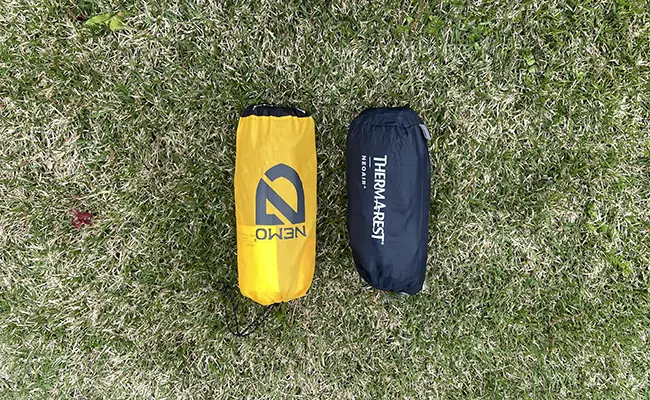
Out of the box, both sleeping pads were impressively small. The X-Lite was slightly smaller, but the difference was minimal. I was impressed there was such a small difference since the Tensor was a Regular, Wide.
I have to give Kudos to Tensor on their stuff sack. They have incorporated a small pouch where the repair kit is stored inside the sack. Little things get me fired up, and I was pretty excited since I always lose my repair kits.
Included with the X-Lite and Tensor

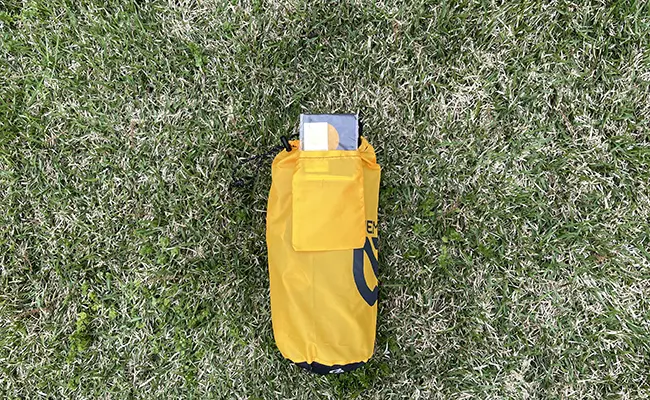
The X-Lite comes with a pump sack, stuff sack, and repair kit, pretty standard additions to any sleeping pad. The Tensor has the same but also includes a Velcro strap for the sleeping pad. I find the strap unnecessary with the stuff sack.
I’ll mention one more time that a small pouch in the stuff sack of the Tensor holds the repair kit. That is just a great idea!
Thermarest X-Lite vs. Nemo Tensor – Features
Both sleeping pads have similar features – pump sacks, “cutting edge” valves, etc., but also a few differences. Even the similarities have differences.
Pump Sacks

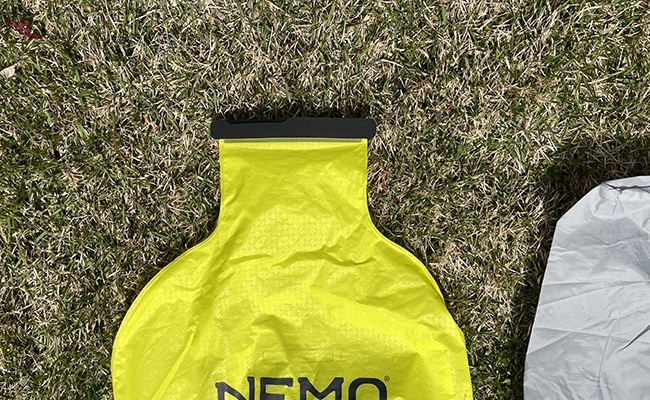

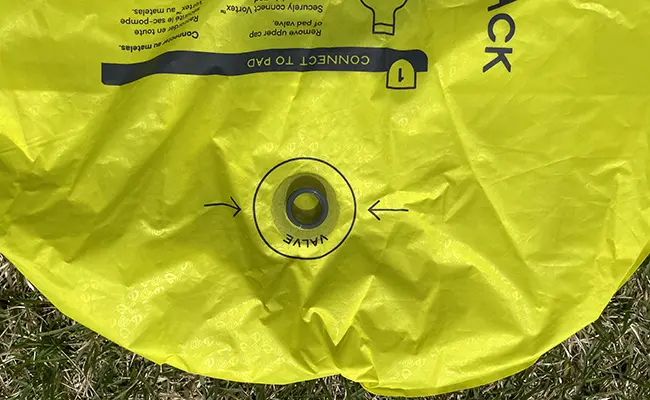
The performance of the pump sacks varies. I wish I could combine the features of each. The best pump sack award went to the Tensor. The tapered neck made it easy to get air into the pump sack, and the more “rubbery” material held air better. The valve was too tight when attached to the pad, though.
It took about six sacks of air to inflate the Tensor pad, making it an easier process.
The Thermarest X-Lite pump sack is a poor design. It felt like the nylon sack did not hold air. The drawstring neck did not help, even when I made a small hole to try and keep in the air. I finally gave up and inflated the sleeping pad more quickly, blowing directly into the valve.
The valve was much easier to attach to the X-Lite pump sack, although almost too easy as it came loose several times.
Valves
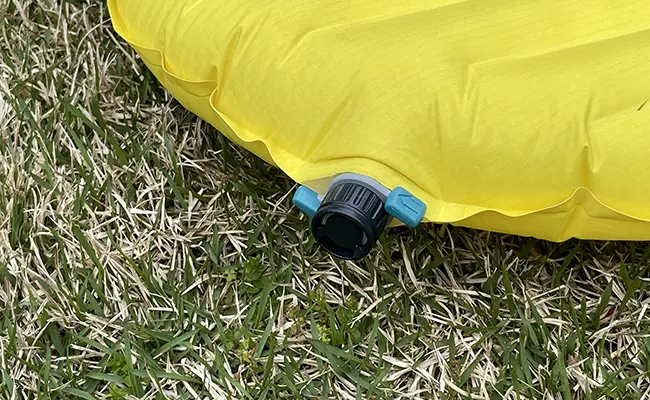
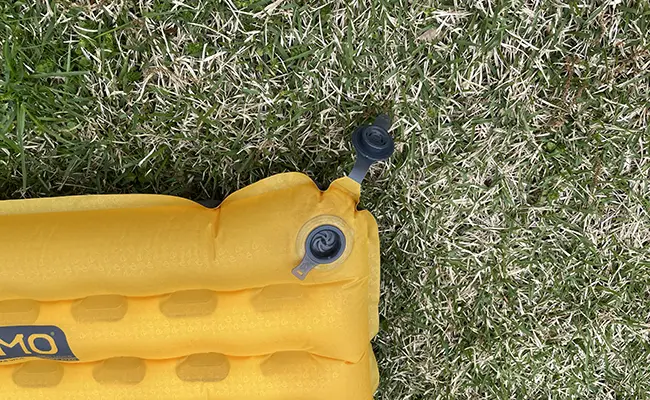
The Nemo Tensor uses a “New Laylow™ zero-profile, multi-functional, micro-adjustable valve.” Say that three times fast. The valve is flat against the pad and comes in two parts. You can open the top cap to bleed off the air, inflate the pad, and pull out the bottom tab to deflate the pad rapidly.
I suspect that this is where the leak is occurring. Even with a little silicone, this is a very tight cap to open and close, placing too much pressure on the glue around the seams. There are other valve complaints on Nemo’s website, and hopefully, they will address them at some point.
The X-Lite uses its trademarked “WingLock Valve.” This valve is one-way when inflated, and you can toggle it open for rapid deflation. The valve is not flat, but it is on the side of the pad in the top corner and not noticeable when I sleep.
I find the WingLock Valve on the X-Lite much easier to use and the pad much easier to inflate by mouth than the Nemo Tensor. There is also less of a stress failure point in the X-Lite valve.
Size

I purchased the Nemo Tensor Regular, Wide. I wanted to experience being able to spread across 25 inches without my limbs dangling. At the end of the day, though, it did not make much difference. Since I’m a side sleeper, I curled up in the middle of the pad, consuming the same amount of space as I did on my 20-inch pad.
If you are a back or stomach sleeper, you will find the Nemo Sleeping pad comfortable. Your arms won’t hang off, which is one of my complaints about the X-Lite when I sleep on my back.
Materials


The Nemo Tensor is made from Bluesign-approved, 100% recycled polyester and uses TPU film insulation technology. The Thermarest X-Lite is made from Nylon, Polyurethane and uses “Thermacapture” to radiate heat back to your body, along with their Triangular Core Matrix technology, two layers of triangular baffles to help minimize heat loss and give the pad more structure.
What does all this technology mean? I found the Thermarest a warmer pad, and both pads are fairly quiet. The Neoair X-Lite used to be incredibly loud, crackling and crinkling all night. I got used to the noise, but nobody wanted to sleep near me. It is much quieter now, but still not as quiet as the Tensor.
Update for 2022: The Nemo Tensor pad now uses Bluesign-approved recycled polyester. They have also incorporated TPU film into the Tensor’s insulation to replace the aluminum film. This has increased the r-value from 3.5 to 4.2.
Thermarest X-Lite vs. Nemo Tensor – Performance
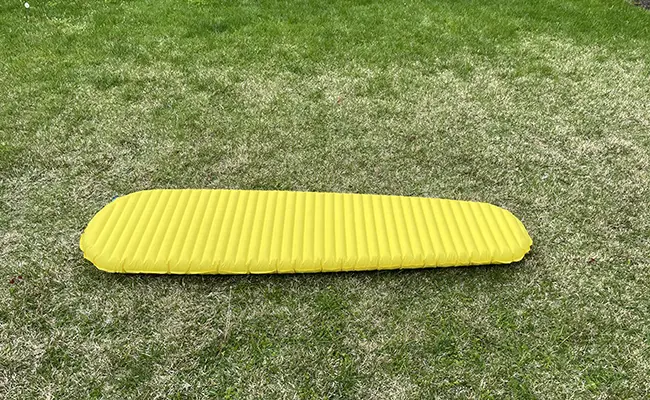

Now for the meat of the review – performance. I always try to test my gear on my hikes and put it through its paces. In this case, I used both of these pads on my Benton MacKaye Trail hike, which was about 2.5 weeks.
Comfort
The X-Lite is comfortable and warm, but waking up with a frozen limb hanging off the sleeping pad is a little annoying. One of the things I looked forward to on my Tensor was not having the bottom of the sleeping pad taper.
I took the Aeon Li with me and failed to check its width. The Aeon Li shelter is 30 inches wide, and the Nemo Tensor is 25 inches. Without putting it on the sleeping pad, there was not enough room for my gear in the shelter. I try hard not to do that because of all the “poking” opportunities.
I preferred the softer material of the Tensor. It was notably softer against my skin and did not feel as if I was sleeping on an inflatable raft.
Both pads were equally comfortable for me as far as thickness, but I found the X-Lite more comfortable even though it is .5 inches less thick. I could better regulate the air pressure with the X-Lite valve – finding the thickness I wanted more easily.
Warmth
In the Spring of 2022, Nemo Tensor changed the insulation material in their pad, and it is now the same as the X-Lite – a 4.2 R-value.
Both pads are now comparable three-season sleeping pads in this category.
Durability
My first night on the Benton MacKaye Trail was cold. I woke up three hours into the night flat on the cold ground. I got out of my sleeping pad, checked the valve, blew up the pad, listened for hissing, and finally went back to sleep.
Three hours later, I woke up flat on the cold ground again! This went on the rest of the night, and I would have to inflate the pad every two hours. This was my routine for the next three nights – ugh. I was exhausted by the time I reached Blue Ridge, GA.
I rode over to Mountain Crossings in Blue Ridge and purchased a Thermarest X-Lite. It was too cold for another sleeping pad failure, and after reading reviews, I realized the Tensor had valve issues. Mountain Crossings also did not have my Tensor in stock, but I would probably not have purchased it anyway.
Warranty
The Warranty is where Nemo and Thermarest differ.
Nemo has a Limited Lifetime Warranty as long as you purchase your sleeping pad from an authorized Nemo Dealer.
I reached out to Nemo and was told that I could not get a refund since I had used the pad, but I could try to work with the retailer where I had purchased the sleeping pad. I could also process a claim, but having them fix a known problem only to have it happen again was not appealing.
A sleeping pad failure can make a hike miserable, especially if I’m several days out from town and it is freezing.
Thermarest also has a Limited Lifetime Warranty, and they also offer a “Better Sleep Guarantee,” although this is only for their sleeping bags and quilts.
The Better Sleep Guarantee states:
“If you are not satisfied with your Therm-a-Rest sleeping bag or quilt, return it within three months of purchase with a copy of the receipt, and we will refund you. No questions asked. We believe a Therm-a-Rest sleeping bag will exceed expectations, and we stand by that belief. It doesn’t matter if you bought it through our website, from another website, or your local retailer; the Better Sleep Guarantee stands.“
Thermarest X-Lite vs. Nemo Tensor – Final Thoughts
Ultimately, I chose to use the warmer X-lite pad because I find it more comfortable for my sleeping style. Recently, Nemo updated the R-Value on the Tensor, so warmth is not a differentiator. This should level the playing field for the comfortable Tensor sleeping pad.
- Comfort – both sleeping pads are comfortable, but I found it easier to adjust the air level on the X-Lite, so it was more comfortable. I also like the vertical baffles that provide me with more support.
- Construction – I had my original Thermarest X-Lite for eight years with no issues and no holes – literally thousands of miles. My Nemo Tensor failed the first night.
- Inflation – the Nemo Tensor has a better pump sack, but the valve is tight. The Thermarest X-Lite has a poor pump sack and a much-loser valve, almost too loose. On the other hand, the X-Lite is much easier to inflate with just the valve.
- Materials – I like the softer material of the Nemo Tensor. As far as sleeping pads go, it is almost “plush.” I also really like the repair kit tucked away in a small pocket in the stuff sack.
- Warmth – As a side sleeper, I found the Thermarest X-Lite warmer with its higher R-Value and heat-retaining technology. Now that Tensor has changed its insulation and increased the R-Value, I will probably be equally warm on both pads.
- Packability – The Nemo Tensor packed up impressively small, considering how much wider it was than the X-Lite.
FAQ
I use warm water and diluted Dawn with a soft brush. I usually clean them in a bathtub.
For me, they are invaluable. My Neoair X-Lite lasted eight years with no patches and is still going strong. A good night’s sleep when backpacking makes for a much better trip.
Most inflatable pads are highly water-resistant, if not waterproof. I’ve occasionally floated in puddles when I made bad tent setup choices.




Hello. Nice review. I use the Tensor insulated Reg Wide. Works great. One thing that’s always been on my mind when comparing mummy to regular is that , with R value taken into consideration, is that it seems by default a mummy should keep a person warmer due to less air space to heat up. I thoroughly enjoy the space of a Reg Wide and usually have the sleeping bag in quilt mode. I’ve been wanting to try an oversize bag and put a mummy style sleep pad inside. Anywho. Peace, ~RL
I agree, that and pad thickness.
Nemo does replace the tensor insulated, had a pin hole in mine after 20 uses in a seam and they replaced it .
Both Nemo and Thermarest have a Lifetime Limited Warranty. I did not want another Nemo pad. I wanted a refund, which they would not provide since I had used the new pad for three days. This is where they differ from Thermarest’s Better Sleep Guarantee.
I have used the Neoair Xlite regular wide and the S2S Etherlight womens wide. My arms do not fall off either pad. The Neoair is considerably warmer, the S2S is much more comfortable but much heavier. I used the Nemo just one night and feel like it falls in between the two pads for comfort. I used it in warmer weather so don’t know where it falls for warmth. Overall I’m happy with the Neoair Xlite now that it comes in a wider version.
I like your review content and format.
I appreciate the feedback on the review and thanks for the insights on the pads.
Good insight – I appreciate the comparison of the “plushness” of them. That’s one thing I’ve heard the Tensor does well!
I have an Xlite Regular Wide, so with all the talk in the review about how the width made a difference for you, I’m wondering how it would have been different if you’d just chosen the wide version. Do you think that would have moved the bar much more in the direction of the Xlite? Seems like a lot of the issues you experienced with the Xlite could have been remedied simply by choosing an equivalently-sized pad (equivalent to the Tensor).
I chose the Xlite over the Tensor because they offer a Regular Wide, vs the Tensor only offers a Long Wide. I’m 5’10 and wide, so I didn’t want to carry the extra weight of a 6’6-sized pad.
Also, the issue with the pump sack has not been my experience (I just bought my Xlite in Nov 2021). I find the pump sack actually kind of hard to pop onto the wingnut valve – and definitely once it’s on there, it feels firm. I’ve never experienced an issue with losing air while pumping it up.
Nonetheless, I really appreciate this article because I think these are the two pads most people choose between, so this is very useful! Thank you!
Hi Julian
Thanks for the feedback. It’s always good to get other opinions.
You are right about ordering a wide in the X-Lite. It is definitely an option. The Tensor was a little too wide for me. I mostly use single person tarp-tents and tents and I could more easily fit my gear in the shelter with me and the regular X-Lite, which I prefer.
It’s good to hear you had a better experience with the pump sack and valve. Mine was definitely loose but worked.
Maybe Nemo has upgraded the Tensor, because the specs say it has an R-value of 4.2—same as the Xlite
Hi
Thanks for the heads up. Nemo did upgrade the pad for 2022, adding TPU film to it’s construction. This looks like a good improvement from 3.5 to 4.2. I’ll update the view.
Heads up — I’ve been reading that the Klymit Insulated Static V ASTM R-value is actually 1.9 (not 4.4), so worth keeping in mind / doing research on if that’s a competitor you’re considering.